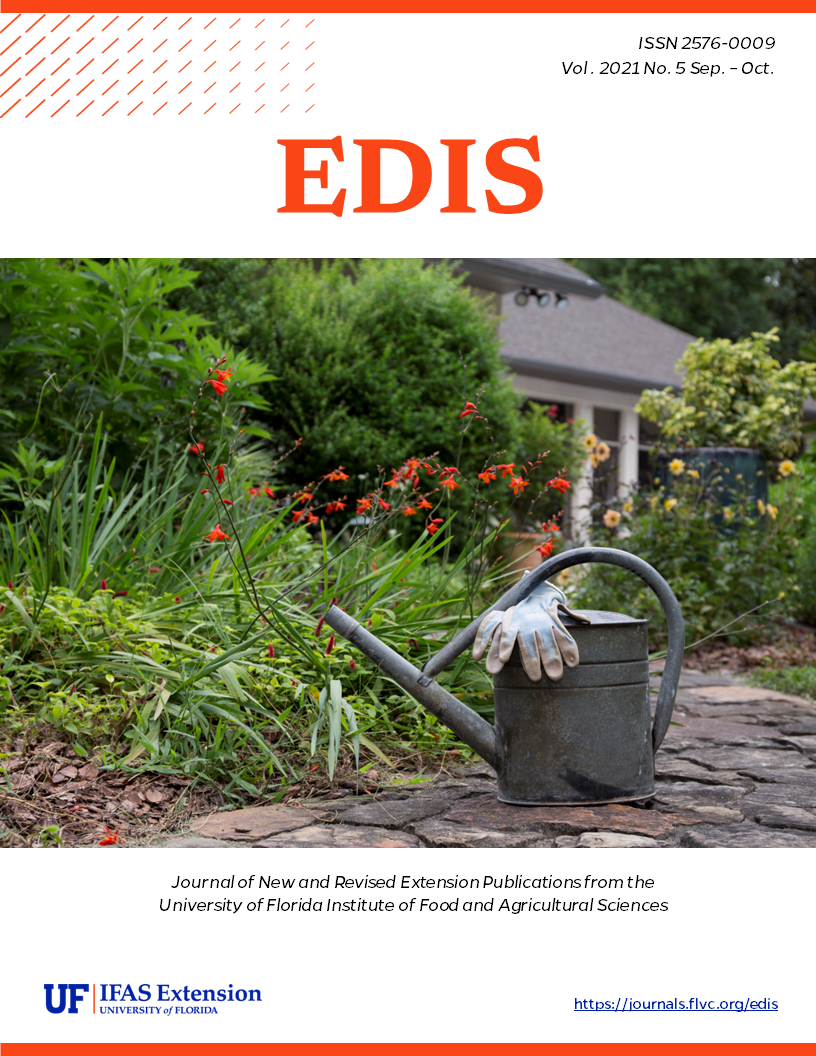Resumen
This publication aims to provide a list of common hazards to consider when manufacturing poultry feeds. Written by Jessica Brown, Ashley Cavallo, Lindsay Zombek, Carli Brown, Arianna Minnie, Mindi Dennis, Gabrielle Allen, and Jason M. Scheffler, and published by the UF/IFAS Department of Animal Sciences, October 2021.
Citas
U.S.C 301. 1938. “Federal Food, Drug, and Cosmetic Act.” https://www.govinfo.gov/content/pkg/COMPS-973/pdf/COMPS-973.pdf
Bucher, O., D’Aoust, J. Y., & Holley, R. A. (2008). Thermal resistance of Salmonella serovars isolated from raw, frozen chicken nuggets/strips, nugget meat and pelleted broiler feed. International Journal of Food Microbiology, 124(2), 195–198. https://doi.org/10.1016/j.ijfoodmicro.2008.03.002
Chen, X., Grenier, B., & Applegate, T. J. (2013). Aflatoxins in Poultry. Purdue Extention, 1–6. Retrieved from https://www.extension.purdue.edu/extmedia/AS/AS-615-W.pdf
CVM, & FDA. (2019). CPG Sec. 683.100 Action Levels for Aflatoxins in Animal Food. Retrieved from https://www.fda.gov/ICECI/ComplianceManuals/CompliancePolicyGuidanceManual/default.htm
Dhama, K., Verma, A. K., Fajagunalan, S., Kumar, A., Tiwari, R., Chakraborty, S., & Kumar, R. (2013). Listeria monocytogenes infection in poultry and its public health importance with special reference to food borne zoonoses. Pakistan Journal of Biological Sciences, 16(7), 301–308.
FAO and IFIF. (2010). Health hazards associated with animal feed. In Manual of Good Practices for the Feed Industry (pp. 1–6). Retrieved from www.fao.org
FDA. (1995). CPG Sec. 575.100 Pesticide Residues in Food and Feed - Enforcement Criteria. Retrieved from https://www.fda.gov/ucm/groups/fdagov-public/@fdagov-afda-ice/documents/webcontent/ucm123236.pdf%0Ahttp://www.fda.gov/ICECI/ComplianceManuals/CompliancePolicyGuidanceManual/ucm123236.htm
FDA. (2015). 21 CFR 514 & 558 Veterinary Feed Directive; Final Rule. Federal Register, 80(106), 31708–31735. Retrieved from https://www.govinfo.gov/content/pkg/FR-2015-06-03/pdf/2015-13393.pdf
FDA. (2019a). 21 CFR 225 Current Good Manufacturing Practice for Medicated Feeds. Retrieved October 20, 2020, from Code of Federal Regulations website: https://www.accessdata.fda.gov/scripts/cdrh/cfdocs/cfcfr/CFRSearch.cfm?CFRPart=225&showFR=1
FDA. (2019b). 21 CFR 507.34 Preventive Controls. Retrieved October 20, 2020, from https://www.accessdata.fda.gov/scripts/cdrh/cfdocs/cfCFR/CFRSearch.cfm?fr=507.34#:~:text=(b) Preventive controls must be written.&text=(ii) The maximum or minimum,hazard requiring a process control.
FDA. (2019c). Listeria (Listeriosis). Retrieved October 20, 2020, from https://www.fda.gov/food/foodborne-pathogens/listeria-listeriosis
FDA. (2019d). Pesticide Residue Monitoring Program Fiscal Year 2017 Pesticide Report. 48. Retrieved from http://www.fda.gov/downloads/Food/FoodborneIllnessContaminants/Pesticides/UCM432758.pdf
FDA. (2019e). Pet Food. Retrieved October 20, 2020, from Animal Food & Feeds website: https://www.fda.gov/animal-veterinary/animal-food-feeds/pet-food
FDA. (2020). Enforcement Report. Retrieved from https://www.accessdata.fda.gov/scripts/ires/index.cfm
Grocery Manufacturers Association, Food Marketing Institute, & GS1 US. (2010). Recall Execution Effectiveness: Collaboration Approaches to Improving Consumer Safety and Confidence. 9.
Ignjatovic, J., & Sapats, S. (2000). Avian infectious bronchitis virus. Scientific and Technical Review of the Office International Des Epizooties (Paris), 19(2), 493–508. https://doi.org/10.1007/978-981-13-9073-9_16
Jackwood, M. W., & Wit, S. De. (2020). Infectious Branchitis. In D. E. Swayne (Ed.), Diseases of Poultry (14th ed., pp. 167–188). John Wiley & Sons, Inc.
Klasing, K. C. (2015). Nutritional Requirements of Poultry. Retrieved October 20, 2020, from Merck Manual Veterinary Manual website: https://www.merckvetmanual.com/poultry/nutrition-and-management-poultry/nutritional-requirements-of-poultry
Li, X., Bethune, L. A., Jia, Y., Lovell, R. A., Proescholdt, T. A., Benz, S. A., … McChesney, D. G. (2012). Surveillance of Salmonella prevalence in animal feeds and characterization of the Salmonella isolates by serotyping and antimicrobial susceptibility. Foodborne Pathogens and Disease, 9(8), 692–698. https://doi.org/10.1089/fpd.2011.1083
Murugesan, G. R., Ledoux, D. R., Naehrer, K., Berthiller, F., Applegate, T. J., Grenier, B., … Schatzmayr, G. (2015). Prevalence and effects of mycotoxins on poultry health and performance, and recent development in mycotoxin counteracting strategies. Poultry Science, 94, 1298–1315. https://doi.org/10.3382/ps/pev075
Nagalakshmi, D., Rama Rao, S. V., Panda, A. K., & Sastry, V. R. B. (2006). Cottonseed meal in poultry diets: A review. Journal of Poultry Science, Vol. 44. https://doi.org/10.2141/jpsa.44.119
National Research Council. (1994). Nutrient Requirments of Poultry.
Pan, D., & Yu, Z. (2014). Intestinal microbiome of poultry and its interaction with host and diet. Landes Bioscience, 5(1), 108–119.
Peng, X., Bai, S., Ding, X., Zeng, Q., Zhang, K., & Fang, J. (2015). Pathological changes in the immune organs of broiler chickens fed on corn naturally contaminated with aflatoxins B1 and B2. Avian Pathology, 44(3), 192–199. https://doi.org/10.1080/03079457.2015.1023179
Peng, X., Zhang, K., Bai, S., Ding, X., Zeng, Q., Yang, J., … Chen, K. (2014). Histological lesions, cell cycle arrest, apoptosis and T cell subsets changes of spleen in chicken fed aflatoxin-contaminated corn. International Journal of Environmental Research and Public Health, 11(8), 8567–8580. https://doi.org/10.3390/ijerph110808567
Porter, R. E. (2019). Poisonings in Poultry. Retrieved October 20, 2020, from Merck Manual Veterinary Manual website: https://www.merckvetmanual.com/poultry/poisonings/poisonings-in-poultry
Rawal, S., Kim, J. E., & Coulombe, R. (2010). Aflatoxin B1 in poultry: Toxicology, metabolism and prevention. Research in Veterinary Science, 89(3), 325–331. https://doi.org/10.1016/j.rvsc.2010.04.011
Scheffler, J. M., & Carr, C. (2016). The Food Safety Modernization Act ( FSMA ) Preventive Controls for Animal Food (pp. 1–3). pp. 1–3. Retrieved from https://edis.ifas.ufl.edu/an330
Shivaprasad, H. L. (2000). Fowl typhoid and pullorum disease. Scientific and Technical Review of the Office International Des Epizooties (Paris), 19(2), 405–424. https://doi.org/10.20506/rst.19.2.1222
Skeik, N., & Jabr, F. I. (2008). Influenza viruses and the evolution of avian influenza virus H5N1. International Journal of Infectious Diseases, 12(3), 233–238. https://doi.org/10.1016/j.ijid.2007.07.002
Spickler, A. R. (2019). Fowl typhoid and pullorum disease. https://doi.org/10.20506/rst.19.2.1222
Toro, H., Van Santen, V. L., & Breedlove, C. (2016). Inactivation of Avian Influenza Virus in Nonpelleted Chicken Feed. Avian Diseases, 60(4), 846–849. https://doi.org/10.1637/11465-070616-ResNote
Vandeplas, S., Dubois Dauphin, R., Beckers, Y., Thonart, P., & Théwis, A. (2010). Salmonella in chicken: Current and developing strategies to reduce contamination at farm level. Journal of Food Protection, 73(4), 774–785. https://doi.org/10.4315/0362-028X-73.4.774
Webster, R. G., Peiris, M., Chen, H., & Guan, Y. (2006). H5N1 outbreaks and enzootic influenza. Emerging Infectious Diseases, 12(1), 3–8. https://doi.org/10.1080/14888386.2006.9712795

